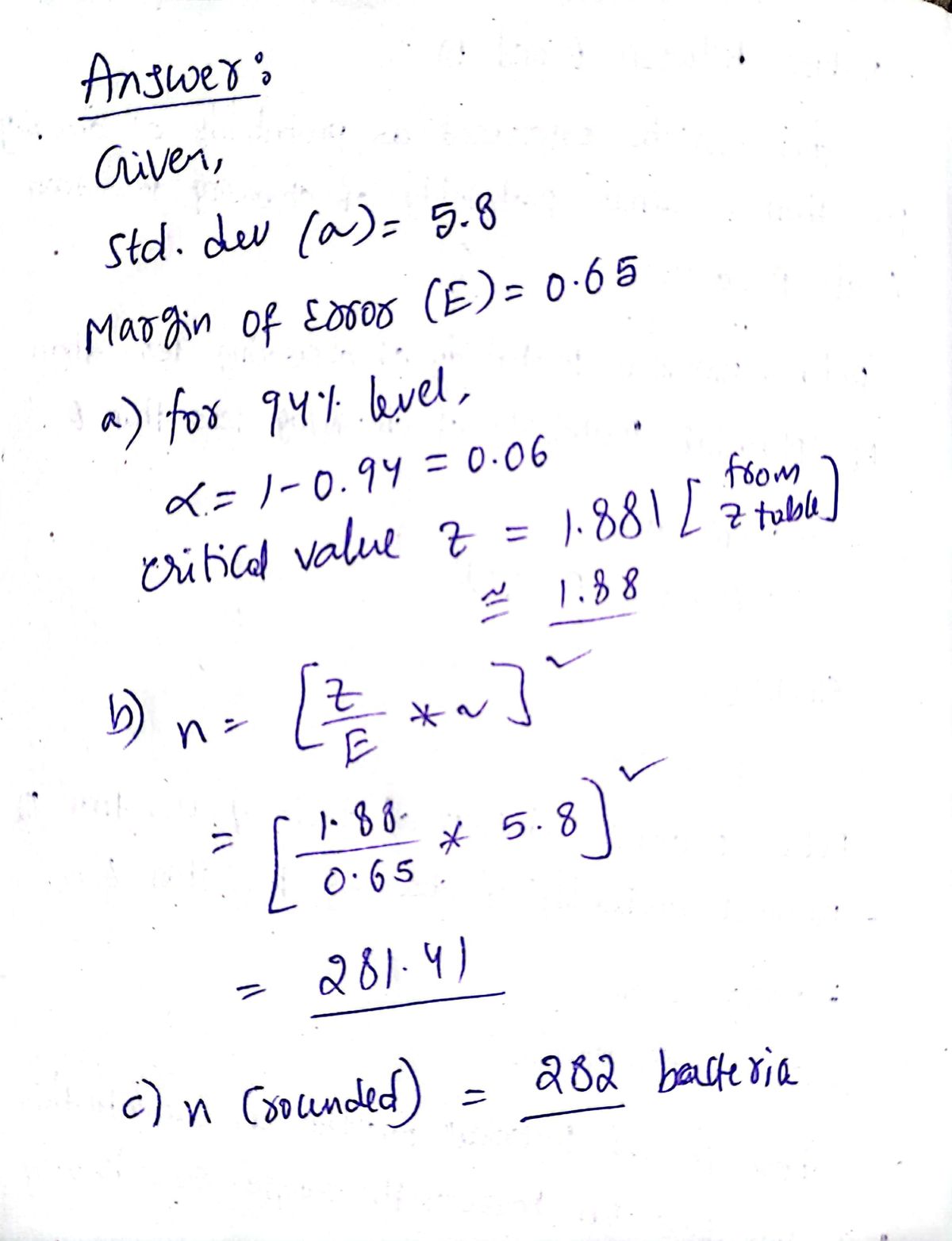What sample size should you gather to achieve a 0.65 hour margin of error? Round your z-value to 2 decimals in your calculation.
What sample size should you gather to achieve a 0.65 hour margin of error? Round your z-value to 2 decimals in your calculation.
MATLAB: An Introduction with Applications
6th Edition
ISBN:9781119256830
Author:Amos Gilat
Publisher:Amos Gilat
Chapter1: Starting With Matlab
Section: Chapter Questions
Problem 1P
Related questions
Question
![**Estimating Sample Size for Bacterial Lifespan Study**
You are a researcher studying the lifespan of a certain species of bacteria. From a previous study, it was found that the standard deviation was 5.8 hours. You would like to estimate the mean lifespan for this species of bacteria to within a margin of error of 0.65 hours at a 94% level of confidence.
**Objective:**
Determine the sample size needed to achieve a 0.65-hour margin of error.
**Instructions:**
1. **Calculate the z-value:**
- Determine the z-value corresponding to a 94% confidence level.
2. **Compute the sample size (n), unrounded:**
- Use the formula for sample size calculation in your study:
\[
n = \left( \frac{z \times \sigma}{E} \right)^2
\]
where:
- \( z \) = Z-value for 94% confidence
- \( \sigma \) = Standard deviation (5.8 hours)
- \( E \) = Margin of error (0.65 hours)
3. **Round the sample size appropriately:**
- Round the calculated sample size to get the nearest whole number, as a sample size must be a whole number.
Note: Ensure to round your z-value to 2 decimal places in your calculations.](/v2/_next/image?url=https%3A%2F%2Fcontent.bartleby.com%2Fqna-images%2Fquestion%2F9968cb77-9bdb-4512-9b62-942115f51f1d%2F6831b3f8-3196-410e-9476-9b0dfda1e6d1%2F8exumba_processed.png&w=3840&q=75)
Transcribed Image Text:**Estimating Sample Size for Bacterial Lifespan Study**
You are a researcher studying the lifespan of a certain species of bacteria. From a previous study, it was found that the standard deviation was 5.8 hours. You would like to estimate the mean lifespan for this species of bacteria to within a margin of error of 0.65 hours at a 94% level of confidence.
**Objective:**
Determine the sample size needed to achieve a 0.65-hour margin of error.
**Instructions:**
1. **Calculate the z-value:**
- Determine the z-value corresponding to a 94% confidence level.
2. **Compute the sample size (n), unrounded:**
- Use the formula for sample size calculation in your study:
\[
n = \left( \frac{z \times \sigma}{E} \right)^2
\]
where:
- \( z \) = Z-value for 94% confidence
- \( \sigma \) = Standard deviation (5.8 hours)
- \( E \) = Margin of error (0.65 hours)
3. **Round the sample size appropriately:**
- Round the calculated sample size to get the nearest whole number, as a sample size must be a whole number.
Note: Ensure to round your z-value to 2 decimal places in your calculations.
Expert Solution
Step 1

Step by step
Solved in 2 steps with 1 images

Recommended textbooks for you

MATLAB: An Introduction with Applications
Statistics
ISBN:
9781119256830
Author:
Amos Gilat
Publisher:
John Wiley & Sons Inc

Probability and Statistics for Engineering and th…
Statistics
ISBN:
9781305251809
Author:
Jay L. Devore
Publisher:
Cengage Learning

Statistics for The Behavioral Sciences (MindTap C…
Statistics
ISBN:
9781305504912
Author:
Frederick J Gravetter, Larry B. Wallnau
Publisher:
Cengage Learning

MATLAB: An Introduction with Applications
Statistics
ISBN:
9781119256830
Author:
Amos Gilat
Publisher:
John Wiley & Sons Inc

Probability and Statistics for Engineering and th…
Statistics
ISBN:
9781305251809
Author:
Jay L. Devore
Publisher:
Cengage Learning

Statistics for The Behavioral Sciences (MindTap C…
Statistics
ISBN:
9781305504912
Author:
Frederick J Gravetter, Larry B. Wallnau
Publisher:
Cengage Learning

Elementary Statistics: Picturing the World (7th E…
Statistics
ISBN:
9780134683416
Author:
Ron Larson, Betsy Farber
Publisher:
PEARSON

The Basic Practice of Statistics
Statistics
ISBN:
9781319042578
Author:
David S. Moore, William I. Notz, Michael A. Fligner
Publisher:
W. H. Freeman

Introduction to the Practice of Statistics
Statistics
ISBN:
9781319013387
Author:
David S. Moore, George P. McCabe, Bruce A. Craig
Publisher:
W. H. Freeman